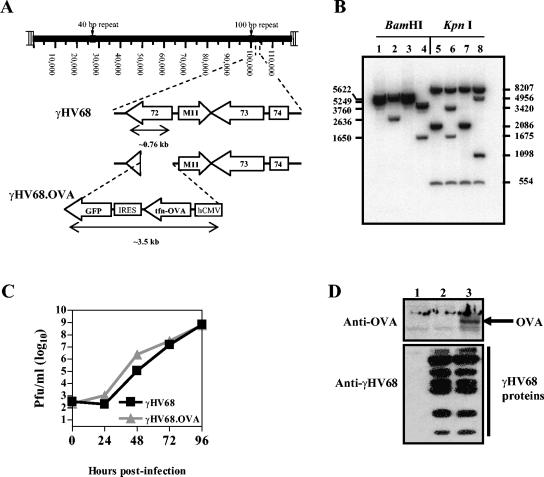FIG. 1.
Generation of γHV68.OVA. (A) Schematic illustration of the γHV68 genome (coordinates in kilobases) including an expanded region demonstrating where the OVA-expressing cassette replaced most of the viral cyclin (ORF72) gene during homologous recombination to create γHV68.OVA. (B) Southern blot hybridization comparing viral genomic DNAs of wild-type γHV68 (lanes 1 and 5), γHV68. OVA (lanes 2 and 6), γHV68.v-cyclin.STOP (lanes 3 and 7), and γHV68.v-cyclin.LacZ (lanes 4 and 8) viruses. DNAs were digested with either BamHI (lanes 1 to 4) or KpnI (lanes 5 to 8). Both γHV68.v-cyclin.STOP and γHV68.v-cyclin.LacZ were included as a controls; they are recombinant viruses produced previously (38) by the same method used to produce γHV68.OVA. The bands seen in lanes 2 and 6 are expected in γHV68.OVA because ∼3,480 bp of the OVA cassette are substituted for 489 bp of the viral cyclin gene. (C) Multistep growth of γHV68.OVA and wild-type γHV68 in NIH 3T12 fibroblasts. Infections were initiated at a multiplicity of infection of 0.05 and monitored for 96 h. The results are representative of two independent experiments. (D) Western blot assay on total cell lysates from 3T12 cells either mock treated (lane 1) or infected for 18 h with wild-type γHV68 (lane 2) or γHV68.OVA (lane 3). The arrow indicates OVA protein only in cells that were infected with γHV68.OVA.

